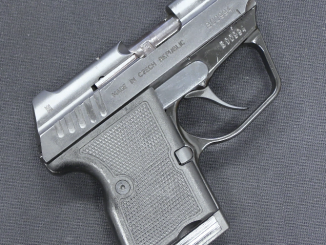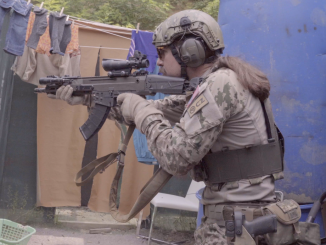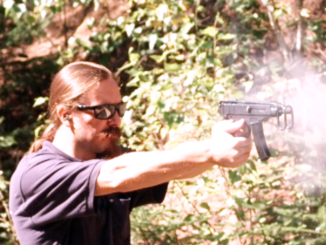This really neat compact PDW prototype was developed by Ladislav Findorak in the 1990s for a Czech military program, although nothing was adopted as a result. The lever-delayed system allows it to have a much lighter bolt and carrier than a typical blowback action, while also remaining very compact and with a surprisingly low rate of fire. Thanks to CZ for giving me access to this really neat prototype from their factory reference collection! Make sure to check them out on Facebook and Instagram.
Related Articles

Semiauto pistol
“Kevin” – A Czech Pocket Pistol With a Weird Delay Trick
The “Kevin” (sometimes called a ZP-98) was developed by Czech gunsmith Antonín Zendl and introduced at the IWA show in 2007. It was a micro-compact pocket pistol chambered for either .380 ACP or 9mm Makarov […]

Competition
Tunnels and Door Breaching: Czech Combat 2024 Day 2
Czech Combat is a 2-day, 12-stage practical matching using rifle and pistol, sponsored by CZ and Sellier & Bellot. It is not a Brutality match, although it shares a lot of elements with Brutality. There […]

Machine pistol
Shooting the Czech vz61 Skorpion: Machine Pistol or PDW?
In the US, the commonly accessible version of the vz.61 Skorpion is the stock-less semiauto pistol – and in that configuration the gun is really nothing like the intentions of its designers. The Skorpion was […]

7:20 This is not quite right. The head starts to move backwards as soon as the cartridge is pushed backwards by the expanding gases. If the head would by held in place by the leaver, there would be no force available to move the leaver. Head, leaver and carrier are all moving together but at differed speeds.
If the head would be held in place with no movement, there would be an outside force necessary to move it. This can be done by recoil (P.38) ore by a gas system (vz.58). But here the bolt head is moving the leaver, like in the FA MAS or the AA-52.
Infact in delayed blowbacks the bolt starts moving the same moment the round is fired. The lever (or the rollers in roller delayed, or the inclined surfaces in radial delayed) only forces the bolt carrier to accelerate faster than the bolt, so exchanging mass (that would be required in a simple blowback) for speed.
Czech Small Arms manufacturing shop in Jablunka CR was originally named Czech Weapons sro.(ltd). They had an entire production line based on L.Findorak’s design principle. https://guns.fandom.com/wiki/Czech_Weapons
As far as I am aware it was during late 90s acquired by a Russian investor connected with another well known designer A.Baryshev. They were offering much the same type of small arms with a smidgen of success. https://en.wikipedia.org/wiki/Baryshev_AVB-7.62
In the current form the company is offering vz.58 rifles and vz.61 SMGs. They are retailed for most part in the U.S. by CZ-USA. https://www.csa.co.cz/
CZW lineup (before foreign acquisition) included 5.56mm rifle as you can see in this video https://www.youtube.com/watch?v=N53ratt-XKw
It seems to operate reliably.
It is of remarkably simple lever-delay design wrapped in a sheet metal tube. It should be a lesson to anyone who thinks they are on path of “world-class” invention. It is not entirely about deemed or real technical proves.
Neat looking rifle, only rate of fire could be lower, imo
The ROF seems to be more or less the one of the FAMAS. It’s inherent with using the lever delayed system in a AR (if you don’t use some trick, like Franchi’s double hammer) since, due to weight concerns, it’s like having a blowback with the minimum mass of the bolt required to safely extract the case.
The design really seems remarkably simple. Both for the receiver and the bolt. The FAMAS was an expensive wepon to manufacture. This seems cheaper than an AR18
I was just going to say the same. All those Kiralyi inspired guns act like that. There is virtually no delay in action to commence opening, although it does so slower than free recoil. In terms of residue contamination it is reduced to chamber and bolt face, but still quite a bit of it.
Mr. Findorak was confident with his mechanism, but it was not a guarantee for success, non-the-less.
The lever-delayed system allows it to have a much lighter bolt and carrier than a typical blowback action, while also remaining very compact and with a surprisingly low rate of fire.
http://www.czechweapons.com/en/czw-9/ claims that it is 780 rounds per minute and Light, compact, fully automatic weapon with an originally designed action. When shooting a burst the gun is extremely precise, it is easy to handle and maintain.(…)This weapon underwent a large scale shooting trials that compared it with different types of Czech and other weapons. When shooting the burst, the precision achieved by CZW9 has been by 40% better than the precision of the competing weapons in the trials.
From http://www.czechweapons.com/en/military-weapons/ existence of following variants might be inferred
SMALL SUB-MACHINE GUN – CZW 9
POLICE SUB-MACHINE GUN – CZW 9 PS
SUB-MACHINE GUN – CZW 9 M
AUTOMATIC CARBINE – CZW 9 FC
Dear Ian!
Ceterum censeo –
– this is not tzeee-zeee.
This – as any Slav would tell you – is ‘čé-zet’.
(tshe-zet)
Dot.
Good effort, but they will not change and for good reason – they do not need to. And please do not ask them to say Cii-ska Zeb-rad-jovka or even worse – Ste-ra-konyichi. I have good time listening to it though 🙂
In one old French publication on pistols I read Ceska Lbropovka (probably meant “brokovka”). That is by far the winner.
On the other hand, I wonder WHY would CZ liguistically tortures its customers. Thus, the “cee-zee” is the easy way out. Keep on “broking” CZ !
As I understand, the delay lever is acting on the disconnector/auto-wear. Interresting idea.
I am wondering if the strange looking charging handle is an attempt at limiting dirt ingress or a way to avoid cutting a slot on the upper.
“(…)auto-wear(…)”
What is this?
Probably SEAR
yes auto-sear, stupid autocorrection!
Charging handle is really genius!
I do not know any other gun using such system.
That was as painful to watch as the Zip 22 video.
This is perfect unfortunate example how theoretical concept on paper and very well made, even looks ok up to the barrel, turns out not feasible in real life and forgotten firearm semi failure.
Obviously whole bolt is too complicated thus it functions unreliably. One giveaway something is amiss is unusually big ejection opening.
Now, I wonder how would it perform with normal blowback bolt.
Of extremely comparable counterpart visually and in size is one also prototype british PDW that uses iirc (cant remember the name now), some kind of electrical system to tune down the rate of fire. Which is also great on paper, but in real life I at least would not want to depend on it to fire the gun.
You must be thinking of the Parker-Hale PDW also know as the Bushman IDW.
Its electronic regulator did not only control the rate of fire. It was also said to increase hits in bursts by holding the fire until the gun came back to its starting orientation.
It’s a prototype. There are a thousand things that could need to be refined for it to work reliably, without the problem being in the “too complicated” bolt (that, for a lever delayed, is quite simple).
90% the problem is in the magazine.
Oh, glad its you again with your dubious, almost always forcibly misunderstood input.
This in theory quite simple multi piece bolt is a nightmare to machine, compared to regular blowback bolts.
In shooting its obvious the interface between the bolt carrier and that disconnector is not working as it should, thus chambered unfired rounds; nothing wrong with magazine.
Overall it looks more of a “0” series gun, then crude toolroom prototype.
Can it all be fixed? Maybe, but I still think ditching the retarded blowback bolt would be the most and only viable benefit, at least if you want reliable, inexpensive gun. Or keeping the system but redesigning it to fixed firing pin.
All this they could conclude long before wise discussions here, but it seems creators/designer chose to not invest in additional improvements, not seeing the light at the end of the tunnel, or the CZ pulled the plug on money bottomless pit.
I didn’t expect someone going personal, especially since I can barely remember having read your nickname before.
But, if that’s the way of discussing you are most comfortable with, I can adapt.
I’m sorry if I can’t agree with your unsupported statement that mistakes your very personal liking for reality.
Reality is that perfectly working production lever delayed SMGs had already been done, even with time and economic constraints, and what had already been done is obviously feasible.
A system that relies on a pair of reciprocating parts to work is obviously a bit more complicate than plain blowback, and it’s done if some other charateristic (lightness of the bolt paired with slow fire rate, IE) is wanted, but two-piece bolts ceased to be a “nightmare” in 19th century.
Hardly the trigger not resetting in a hammer fired weapon has something to do with the bolt being “too complicate”. There are hundreds of ways a disconnector can work, indipendently from the existence of a bolt carrier.
There are hundreds of reasons a prototype don’t go into production too. Hundreds of plain blowback prototype SMGs never went into production. Was it because blowback operation was too complicate and not feasible?
“(…)some kind of electrical system to tune down the rate of fire. Which is also great on paper, but in real life I at least would not want to depend on it to fire the gun.”
https://guns.fandom.com/wiki/Parker_Hale_PDW claims that
The PDW was a blowback-operated submachine gun that utilized a hydraulic regulator to moderate the rate of fire. This was electronically powered by batteries stored in the pistol grip. The regulator could be modified to give fire rates between 200 and 400 rounds per minute; disabling the regulator would cause the weapon to fire at 1,400 rounds per minute.
So to my understanding if said mechanism would refuse to work, gun itself would still be able to fire, though it was be in awful fast mode.
Yeah, thats it, “Bushman” !!
I was thinking before it was some kind of system where hammer release was directly actuated by electrical circuit, that sounded potentially very problematic.
Maybe some patent exists describing the hydraul.regulator, but I’m mentally too exhausted now to investigate it all.
Would really like to see firing video, and ofc Ians review. Hope we will one day, at least that british royal armouries museum curator, recently very youtube happy, surely could access it somewhere.
“(…)Of extremely comparable counterpart visually and in size is one also (…)”
For mass-wise similar blow-back operated 9×19 sub-machine gun see PP-2000
https://modernfirearms.net/en/submachine-guns/russia-submachine-guns/pp-2000-eng/
Addendum other size-wise similar sub-machine gun is Steyr TMP https://modernfirearms.net/en/submachine-guns/austria-submachine-guns/steyr-tmp-eng/
Interesting use of the color red for “safe”, there.
I’ve always said it was arbitrary, and indicative of the thinking of the designer, more than being some “always” thing. You can frame it as “Red means danger”, and then interpret the actual danger as being “not ready to fire” in order to defend yourself. The fact that we’ve typically used red for “chamber loaded, prepared to fire” isn’t a fixed thing, and viewpoints matter. For a weapon intended to be used as a PDW in exigency, this kinda makes logical sense. Sort of. I’d suggest, strongly, however, that a continuity of usage for the color would make more damn sense, and it really ought to be standardized as “red means ready to fire” rather than “red means weapon is dangerous because it isn’t ready to fire”.
It’s an outlook thing. I once got in an argument with a guy because he insisted that the color red was a universal sign of danger, and it’d always be used for something like “ready to fire”. My point was that while the color might be a universal sign of danger, the interpretation of what was actually dangerous was fairly open… We wound up agreeing to disagree, since we had no way of really telling whether our arguments made any damn sense.
Point we were discussing was “OK, aliens have invaded, you’ve captured some of their small arms… How do you figure out how they work?” For the purposes of discussion, we were supposing that said aliens were basically humanoid with pretty much our same set of senses and so forth (otherwise, why the hell would they be invading earth…?).
It was late, we needed to stay awake, and arguing about silly shit was about the only way we could manage it. I still contend that the assignment of “danger” to a particular condition of a weapon is more cultural than not; you think of a weapon as dangerous when it’s not instantly ready to defend yourself with, and you’re going to color what we usually consider “safe” with the sort of flagging signal that we use for “ready to fire”.
This is actually the first weapon I’ve seen where that logic is followed, TBH.
Its possible in the end its a simple mistake in dot placement, or order of modes; or maybe it was meant to be painted green?
Good info and analysis